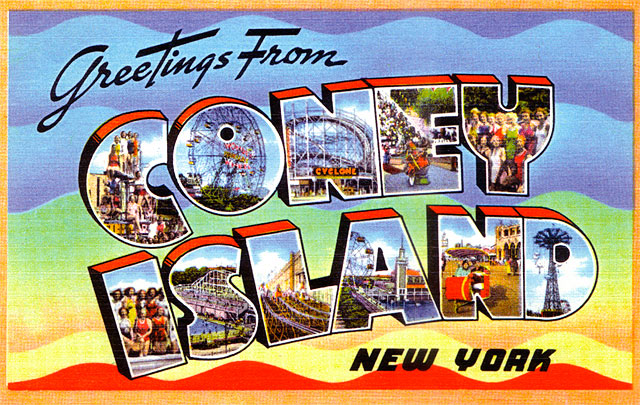You can't mention seaside amusement parks without thinking of Coney Island. I recently visited NYC for my first time and made seeing this historic site a priority. Located in southernmost Brooklyn, New York City, Coney Island is a peninsula / former island, separated from Brooklyn by Coney Island Creek. If there is one thing that Coney Island is known for it's Nathan's Hot Dogs topped with chili. The chili flavor is so unique that people search recipes online where they can learn how to cook chili that tastes just like Nathan's for their hot dogs. Between the 1880s and WWII, Coney Island was the largest amusement area in the United States, attracting several million visitors per year, even spawning many summerhouses in the area. At its height it contained three competing major amusement parks, Luna Park, Dreamland, and Steeplechase Park, as well as many independent amusement operators. |
 |
Pictured above is the "Coney's Colossus" Elephant Hotel which was located on the site that would later become Luna Park. This tin & wood frame building was built by James Lafferty in 1884. The elephant stood 150 ft. tall and had 34 rooms, including a cigar stand in a rear leg. The structure burned in 1896.
Luna park. Built in 1903 by Skip Dundy and Fred Thompson and named for Skip's sister, Luna Dundy. Luna Park was famous for it's fantasy architecture and lighting, which included 1,200 towers and minarets. After declining in the 1930s, it closed on 1945, following a series of fires.
|
Coney Island reached its peak in the early 20th century. It declined in popularity after World War II and endured years of neglect. In recent years, the area has seen the opening of KeySpan Park, home to the successful Brooklyn Cyclones minor league baseball team. On September 7th, 2008 Astroland, one of two surviving major parks, closed for good. Astroland owner Carol Hill Albert, whose husband's family had owned the park since 1962, sold the site to developer Thor Equities in November 2006 for an undisclosed amount. Thor proposed a $1.5 billion renovation and expansion of the Coney Island amusement area to include hotels, shopping, movies, an indoor water park and the city's first new roller coaster since the Cyclone. The development company said it hoped to start construction in 2008 and complete the project by 2011. The Aquarium is also planning a renovation. The other major park, Deno's Wonder Wheel Amusement Park is a successful family owned park with over 20 rides located directly on the Boardwalk. A handful of independents such as the12th Street Amusements, and Kiddie Park are also operating. The Eldorado arcade has its own indoor bumper car ride. The Zipper and Spider on 12th Street were closed permanently on September 4, 2007 and dismantling begun, after its owner lost his lease. They were shipped off, to be reassembled at an amusement park in Honduras. Three of the rides at Coney Island are protected as designated NYC landmarks and recognized by the National Register of Historic Places.
The Cyclone roller coaster, built in 1927, is one of the nation's oldest wooden coasters still in operation. A favorite of some coaster aficionados, the Cyclone includes an 85-foot (26 m), 60 degree drop. It is owned by the City, and operated by Astroland, under a franchise agreement. It is located across the street from Astroland.
The Parachute Jump, originally the Life Savers Parachute Jump at the 1939 New York World's Fair, was the first ride of its kind. Patrons were hoisted 190 feet (58 m) in the air before being allowed to drop using guy-wired parachutes. Although the ride has been closed since 1968, it remains a Coney Island landmark and is sometimes referred to as "Brooklyn's Eiffel Tower." Between 2002 and 2004, the Jump was completely dismantled, cleaned, painted and restored, but remains inactive. After an official lighting ceremony in July 2006, the Parachute Jump was slated to be lit year round using different color motifs to represent the seasons. However, this idea was scrapped when New York City started conserving electricity in the summer months. It has not been lit regularly since.
|
|
|
Steeplechase Park. Opened in 1897 by George C. Tilyou. The Steeplechase Ride was built by George Tilyou because he felt his park needed a ride that rivaled the Shoot-the-Chutes found at Paul Boyton's Sea Lion Park. Tilyou heard about an English ride that replicated a horse race and felt it was exactly what his park needed to draw crowds across Surf Avenue. When the parked burned in 1907, Tilyou erected a fence around the property and charged 10 cents to see the smoldering ruins. The rebuilt amusement park featured a five-acre steel-and-glass pavilion that remained open on rainy days. Steeplechase Park closed in 1964 and was demolished in 1966. |
Dreamland Park. Built in 1904 by William H. Reynolds to compete with luna Park. Dreamland was known for it's magnificent 375-foot-tall central tower and white classical architecture and statuary. The park burned in a spectacular fire on May 27, 1911. Today Coney Island has one of the cleanest beaches in the New York City area. Every morning a cleaning crew rakes the beach to remove tons of garbage from the previous day. The cleaning service often finds lost belongings like jewelry and cell phones during the early morning job. |